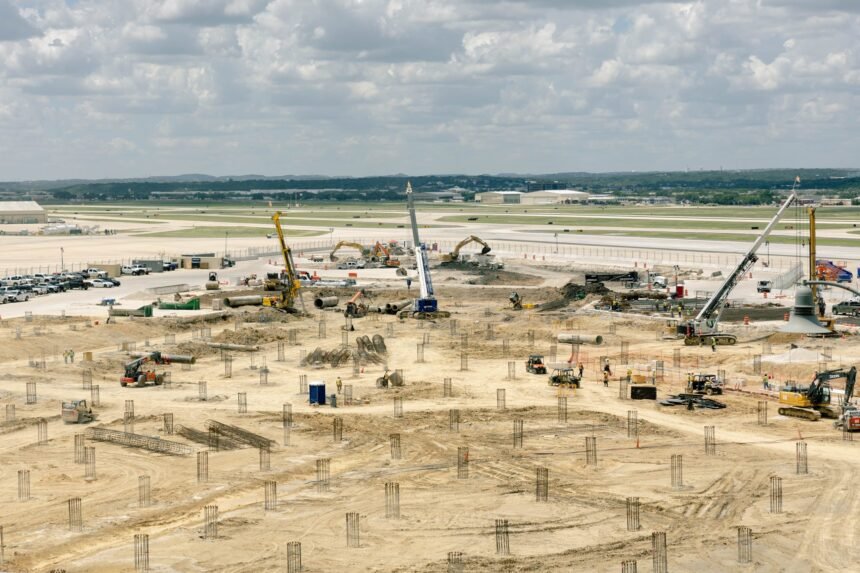Close to 3 million people a day have been processed through national airport security checkpoints since summer began.
That data from the Transportation Security Administration reflects the season’s expected steady rise in travel — a wave that comes even as aviation analytics firms say the global airline industry is feeling some heat due to macroeconomic pressures, geopolitical instability and evolving consumer behavior.
At the San Antonio International Airport (SAT), despite the sea of cars in every parking lot and garage, and crowded gate areas, annual passenger counts are down so far about 2.5% below what was projected for the year.
In May, the airport’s passenger numbers reached 966,077, a decrease from 974,078 during the same month in 2024.
But the level of activity on everything from airport improvement projects — as detailed in a 20-year, $2.5 billion Airport Strategic Plan — to responding to an ongoing lawsuit has not slowed.
The San Antonio airport had a record-breaking 2024 in terms of enplanements, and while statistics for this year aren’t what was expected, it could be worse, said Jesus Saenz, director of airports for the City of San Antonio.
“We keep our finger on the pulse of what’s happening and continue to monitor that,” Saenz said. But, “we are faring incredibly well compared to other cities,” including those that connect directly to Southeast Asia that were more affected by the COVID-19 pandemic and others that connect to Canada and some European and Central Mexico destinations.
Here are the takeaways from the Report’s recent conversation with Saenz for an update on all things SAT.
Terminal C
More than 200 of the planned 800 support pillars have already been installed into the core of a new and modern terminal that will expand the airport by 13 gates.
City officials broke ground on the $1 billion project in December and site work near Terminal B began the following day.
With 65% of the designs nearly complete, Saenz said, construction on the building will begin later this year as crews work toward a 2028 completion date.
The existing concourses won’t be left behind, however. San Antonio’s aviation officials are looking ahead to revitalizing Terminals A and B with new checkpoints, concession spaces and hold rooms, and are working on a solicitation for proposals that will be released soon, Saenz said.
Transportation and parking
There are more than 9,000 vehicle parking spaces in garages and on surface lots at the San Antonio airport, many of which are fully used during peak travel times.
With the addition of a planned ground transportation center to be built west of the existing long-term garage, that number will grow by 2,000.
It won’t happen overnight — the expected completion date is mid-2027. But in addition to providing a centralized location for all ground transportation options, including shuttles, rideshares and taxis, the transportation center will be built to structurally accommodate electric vertical take-off and landing operations.
“We’ve had some really peak days — close to 20,000 on some days of passenger traffic … and we’re reaching capacity in a number of our parking facilities,” Saenz said. “So that could not happen sooner, and we’re moving as aggressively as possible to get that built and designed as quickly as we can.”
Last year, city officials chose to outsource management of its vehicle parking services and implemented an online reservation system and also an artificial intelligence system never before used in the United States. The transition hasn’t been without hiccups.
“Nothing is perfect as soon as we come out of the chute,” Saenz said. “We’re the first airport to offer this, but I will tell you, here recently, it has improved dramatically.”
Ground load facility
Under construction near Terminal A, and visible from the vehicle departure and arrival lanes, is the airport’s newest major project.
Due to open in December, the ground load facility (GLF) will allow passengers to board or exit a plane from the tarmac, similar to how air travel looked before jetways came into widespread use.
Ground loading makes boarding more efficient and less expensive for airlines than traditional terminal gates and thus makes for quicker flight turnaround times.
It’s especially attractive to ultra-low-cost carriers, but which airlines will use the facility, and what destinations they provide, has not been disclosed due to agreements with the airlines. An announcement will be made in the coming months, Saenz said.
“We’re already in some serious discussions with a number of carriers on how we’re going to best utilize that facility, and it’s exciting to hear that it’s all going to be spoken for here pretty soon,” he said.
Runways and roadways
In addition to both maintenance and construction on some of the airport’s taxiways that will start in January, some of it funded through grants from the Federal Aviation Administration, preliminary work has already begun on the vehicle roadways in preparation for Terminal C.
“We’re going to take that from a four-lane to a six-lane on the actual roadways that are adjacent to the face of the terminal complex, and that will be from Terminal A all the way to the new terminal,” Saenz said.
Southwest lawsuit
Saenz declined to talk about the ongoing case brought by Southwest Airlines in September over its proposed gate assignments.
The low-cost airline, which currently dominates the largest terminal at SAT, says it was promised space in the new terminal but that city leaders reneged on the agreement. Southwest sued the City of San Antonio.

In March, the city’s lawyers filed a motion to dismiss, saying that “all of the airport’s major airlines” wanted placement in the new terminal, and it was “inevitable that one or more airlines would be unhappy with their gate assignments.”
Though a judge agreed to allow the city to proceed with its planned gate assignments, Southwest Airlines’ lawyers have been using the legal discovery process to pour through internal city documents to expose what they depict as dishonest interactions with city leaders.
A series of motions and responses followed through the end of May.
“We want this to come to a resolution,” Saenz said. “We care about all of our carriers, and we want all of our carriers to be successful, and we continue to work towards a finish line with them.”
Destinations
In the span of a year, San Antonio officials have marked major gains and losses in air service.
In October, the city celebrated its long-sought nonstop air service to Ronald Reagan Washington National Airport (DCA). In December, Condor announced it was ending the airport’s first nonstop transatlantic flight, after only one season.
“In our 36-month strategy, [the transatlantic flight] does not go away,” Saenz said. “We want to continue to have transatlantic service between San Antonio and a destination in Europe. We are constantly in communication with all of those international carriers wanting to make those connections.”
The daily DCA flight is “performing incredibly well,” Saenz said. “We’ve had conversations with American Airlines, and you look at the performance of that route and it’s yielding great numbers.”
In May, Frontier Airlines launched nonstop service to Atlanta (ATL) while Spirit
Airlines added nonstop flights to both Detroit (DTW) and Nashville (BNA). Seasonal carrier Sun Country also resumed flights to Cancun (CUN) and Minneapolis-St.
Paul (MSP).
More new air service is on the horizon, expanding the San Antonio airport’s connectivity with Mexico, Saenz said. On July 5, Volaris Airlines will launch flights to both Morelia (MLM) and San Luis Potosi (SLP).












